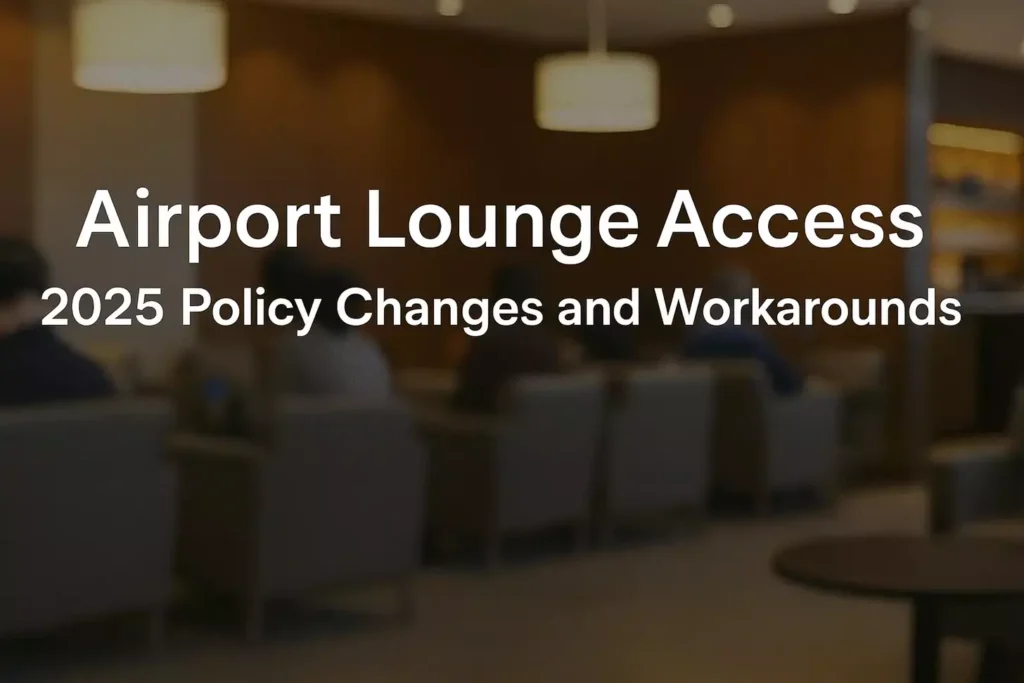Affiliate Disclosure: Award Travel Hub may earn a commission or referral bonus from some links on this site. These affiliate links help support our work and may influence the placement or promotion of certain products or services. However, our content is independently crafted to reflect honest opinions. Not all offers or products are included. There is no additional cost to users when they utilize our affiliate links.
A stunning 70% of premium cardholders will see their lounge benefits altered this year. This shift is reshaping the entire premium travel landscape.
Once quiet retreats, these spaces are now facing unprecedented crowds. The very appeal that made them desirable is under pressure from new rules.
We are here to guide you through this complex transition. Major programs from Delta to Capital One are introducing significant new restrictions.
Our analysis provides clear, actionable strategies. We help you maintain a premium experience despite the tightening rules across the industry.
Understanding these updates is crucial for maximizing your credit card value. We break down the complex details into simple, practical plans.
Key Takeaways
- A vast majority of travelers will encounter new lounge restrictions in 2025.
- The era of easy entry is ending, requiring more strategic planning.
- Major airlines and credit card issuers are leading this industry-wide shift.
- Staying informed is key to protecting the value of your premium memberships.
- Practical solutions exist to navigate these changes successfully.
- We provide data-driven insights to help you make confident decisions.
Overview of Airport Lounge Trends in 2025
We are witnessing a fundamental democratization of travel luxury, challenging the very foundations of lounge culture. The quiet sanctuaries of the past are now bustling hubs, a change driven by powerful market forces.

Market dynamics and evolving travel luxury
A $300 billion surge in post-pandemic travel spending created unprecedented demand. Delta’s CEO, Ed Bastian, called this “beyond anything that people can classify as truly pent-up.” This “revenge travel” phenomenon has reshaped expectations.
Luxury is no longer just for the ultra-wealthy. Research from Airport Dimensions confirms this shift, stating these spaces have become.
“the definitive democratic travel luxury.”
This creates a squeeze. A new demographic of “everyday millionaires” expects premium experiences. But their membership often doesn’t guarantee the exclusive experience they seek.
Key statistics and growth drivers
Several factors fuel this growth. The proliferation of premium credit cards offering lounge benefits as a standard perk is a major driver. Strategic partnerships between airlines and financial institutions have also expanded eligibility significantly.
This expansion strains physical capacity. Airlines and card issuers now struggle to balance profitability with customer satisfaction. They are responding with new models to manage crowds and protect value for their most loyal customers.
Understanding these dynamics is key. It helps us predict which programs will maintain their premium travel appeal and which may introduce further restrictions.
Understanding Airport Lounge Access: 2025 Policy Changes and Workarounds
A new era of restrictions is reshaping how travelers experience premium waiting areas before flights. We’ve identified three major categories of adjustments that will impact your lounge access strategy.

Summary of major policy updates
Visit limitations and spending requirements represent the first significant shift. Starting February 2025, Delta implemented annual caps of 15 lounge visits per year for American Express cardholders. Unlimited access now requires exceptional spending thresholds above $75,000 annually.
The three-hour pre-departure window eliminates extended stays. This change forces travelers to time their arrival more precisely rather than using these spaces as all-day workspaces.
Guest policies are undergoing dramatic transformations. Capital One’s 2026 adjustments remove complimentary lounge access for authorized users unless cardholders pay $125 per additional card. Guest fees now range from $35 to $45, depending on the lounge type.
Cross-border requirements introduce another layer of complexity. Mastercard Travel Pass mandates at least one international transaction to unlock three months of access. This creates a usage-based model with annual visit limits varying by card tier.
These changes reflect a clear industry trend toward financial barriers and usage restrictions. Understanding these specific updates helps us develop strategic approaches to maintain your membership value throughout the calendar year.
Delta’s Premium Lounge Strategy and Market Position
Delta Air Lines is charting a bold course in the premium travel space with significant investments. Their strategy combines luxury tier creation with massive capacity expansion.
Delta One Lounges: New features and exclusive amenities
The airline is elevating the lounge experience through dedicated lounges. These facilities feature fine dining options and spa-like wellness treatments.
Valet services and premium amenities distinguish these spaces from standard offerings. The focus is on creating an exclusive environment for high-value customers.
| Lounge Tier | Key Features | Target Audience | Locations (2025) |
|---|---|---|---|
| Delta One Lounges | Fine dining, spa treatments, valet service | International business class | Seattle, JFK, Boston, LA |
| Sky Clubs | Premium food, workspaces, showers | Premium cardholders, elite members | Major hubs nationwide |
| Partner Lounges | Basic amenities, partnership access | American Express Platinum holders | Select domestic locations |
Efforts to address overcrowding and improve guest experience
Delta is tackling capacity challenges through massive expansion projects. Facilities exceeding 30,000 square feet are underway in key hubs.
The partnership with American Express created both opportunity and crowding challenges. CEO Ed Bastian addressed this directly:
“We’re investing billions to restore the premium experience our customers expect.”
Their target demographic includes households earning $100,000+ annually. This broad approach explains unique crowding challenges compared to competitors.
By 2026, executives predict the resolution of most capacity issues. The combination of physical expansion and access management aims to balance demand.
Credit Card Policies: Benefits, Changes, and Guest Fees
Cardholders face new fee structures and access limitations across major credit card programs. We’re analyzing how these adjustments impact the value proposition of premium travel cards.
Capital One Venture X Rewards Credit Card adjustments
The Venture X card undergoes significant changes starting in February 2026. Currently, this credit card offers generous complimentary lounge access for primary users and authorized users.
After the update, authorized users must pay $125 per card for privileges. Primary cardholders will face guest fees at Priority Pass locations.
Comparative review: Premium travel cards and their lounge benefits
We compare how major cards stack up against the new Venture X structure. Each program offers distinct advantages for different travel styles.
| Credit Card | Annual Fee | Authorized User Fee | Guest Policy | Lounge Network |
|---|---|---|---|---|
| Capital One Venture X | $395 | $125 (2026) | $35-45 per guest | Capital One, Priority Pass |
| Amex Platinum | $695 | $195 | $50 Centurion, comp PP | Centurion, Priority Pass |
| Chase Sapphire Reserve | $550 | $195 | Two complimentary guests | Sapphire, Priority Pass |
High-spending cardholders can unlock additional benefits. Those exceeding $75,000 annually receive enhanced guest privileges.
The Chase Sapphire Reserve emerges as the most generous for guest access. It maintains two complementary guests across its network without incurring additional costs.
International and Cross-Border Lounge Access Requirements
A simple $1 purchase abroad can unlock months of premium travel amenities through Mastercard’s program. This innovative approach ties benefits directly to actual card usage rather than passive ownership.
We find that this system actually benefits frequent international travelers. The minimal spending requirement creates an active engagement model.
Mastercard Travel Pass and cross-border spending mandates
The DragonPass network requires eligible cardholders to make at least one international transaction. This $1 minimum purchase activates three months of complimentary lounge access.
Without this qualifying purchase, benefits become limited. Platinum and World cardholders receive one complimentary visit, while World Elite members get two visits.
The calendar year structure runs from January 1st to December 31st. Unused lounge visits do not carry over to the following year.
Cardholders can track their remaining visits through the Mastercard Travel Pass app. This provides real-time visibility into benefit status.
We recommend making international purchases at least 72 hours before travel. This ensures seamless reinstatement of full privileges.
Impact of Elite Overproduction on Lounge Experiences
The crowding crisis affecting premium waiting areas reflects a deeper sociological phenomenon. We turn to academic research to understand why exclusive spaces feel increasingly crowded.
Societal shifts and the dilution of exclusive benefits
University of Connecticut professor Peter Turchin developed the “elite overproduction” theory. His research shows society creates more people aspiring to elite positions than available spots.
Turchin explains this dynamic perfectly:
“The benefits that you get with wealth are now being diluted because there are just too many wealth holders.”
The top 10% of American society has grown significantly wealthier over the past forty years. This creates a massive class of “ten-percenters” expecting premium benefits.
These spaces have become the perfect metaphor for this societal shift. What was once a clear status marker now represents crowded frustration.
Ritholtz Wealth Management’s Nick Maggiulli observes that “the upper middle class isn’t special anymore.” Too many people with wealth expect exclusive experiences.
This explains why even legitimate high-status travelers struggle with their membership benefits. The promised value diminishes through sheer numbers.
Understanding elite overproduction helps contextualize restrictive policies. Companies attempt to recreate artificial scarcity where natural exclusivity has vanished.
Strategic Workarounds and Alternatives for Premium Travel
Strategic planning becomes your most valuable asset in navigating the evolving premium travel landscape. We’re helping travelers adapt their approaches to maintain exceptional experiences despite new limitations.
Smart portfolio management can significantly enhance your benefits. Instead of relying on one premium credit card, consider stacking complementary rewards programs.
Maximizing Your Benefits Through Smart Strategies
Timing your arrival within the three-hour window ensures you make the most of your visit. Plan your schedule carefully to avoid being turned away at the entrance.
For Capital One cardholders facing 2026 adjustments, evaluate if the $75,000 spending threshold aligns with your business expenses. Meeting this goal unlocks valuable guest privileges for two full calendar years.
Mastercard users should make small international purchases to maintain continuous three-month access windows. Even a $1 online transaction counts toward this requirement.
We recommend exploring alternative networks beyond major programs. Smaller regional clubs and Priority Pass restaurants often provide less crowded premium experiences.
Business cards frequently receive different treatment during policy updates. The Venture X Business or American Express Business Platinum may maintain more generous guest policies.
Calculate your actual usage from the past year to determine if unlimited programs justify their costs. Sometimes, capped programs with lower fees deliver better value for your specific travel frequency.
Conclusion
We’ve reached a pivotal moment where understanding the fine print of your benefits is more crucial than ever. The landscape for premium travel perks has fundamentally shifted, requiring strategic thinking from every cardholder.
Our analysis reveals that success now depends on matching your spending patterns with the right programs. High-value travelers who meet specific thresholds can still enjoy exceptional benefits throughout the calendar year.
We encourage you to view lounge privileges as one component of a comprehensive rewards strategy. The true value comes from combining multiple benefits like travel credits and dining options.
Your membership delivers maximum value when you align it with your actual travel habits. Strategic planning ensures you extract every dollar of value from your premium credit cards.
Armed with this information, you can navigate these changes confidently. The right approach turns restrictions into opportunities for smarter travel decisions.



